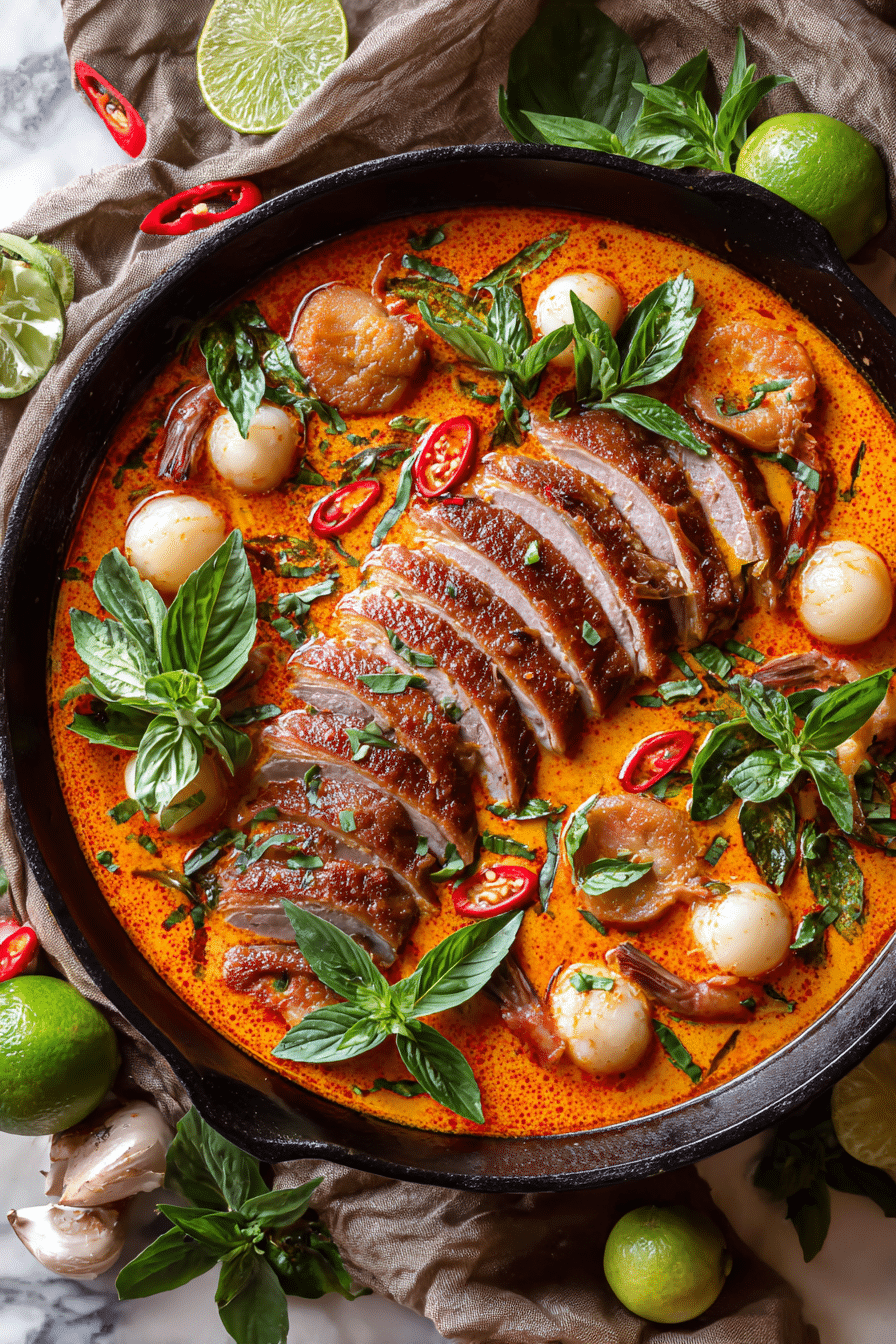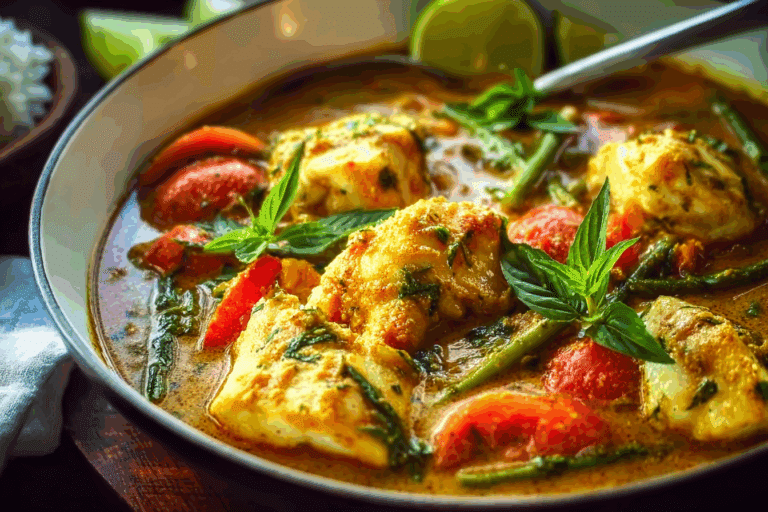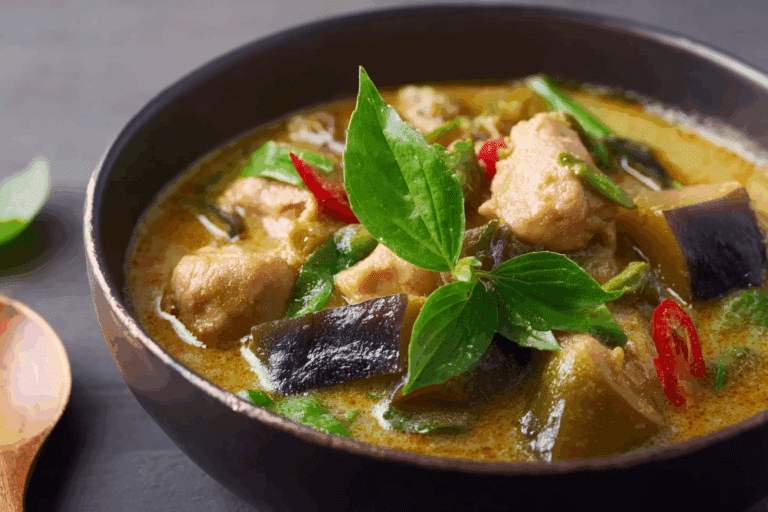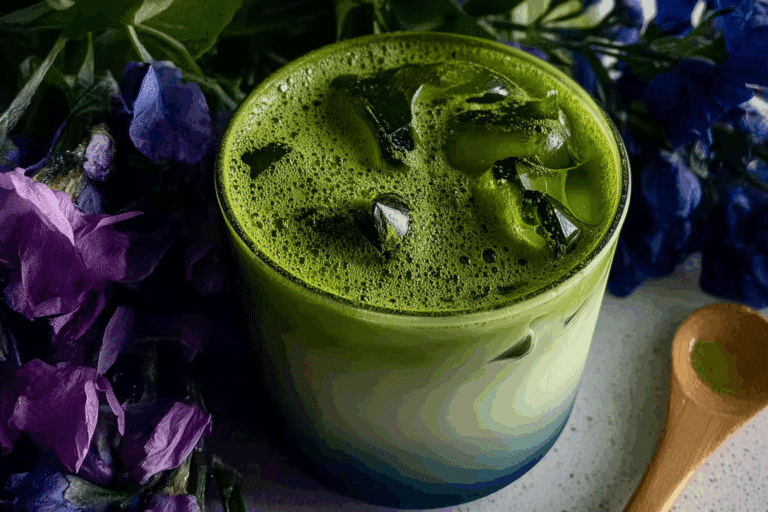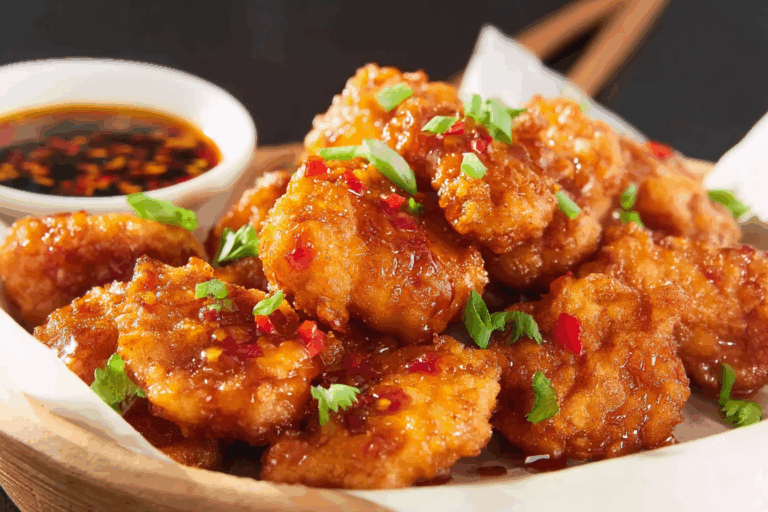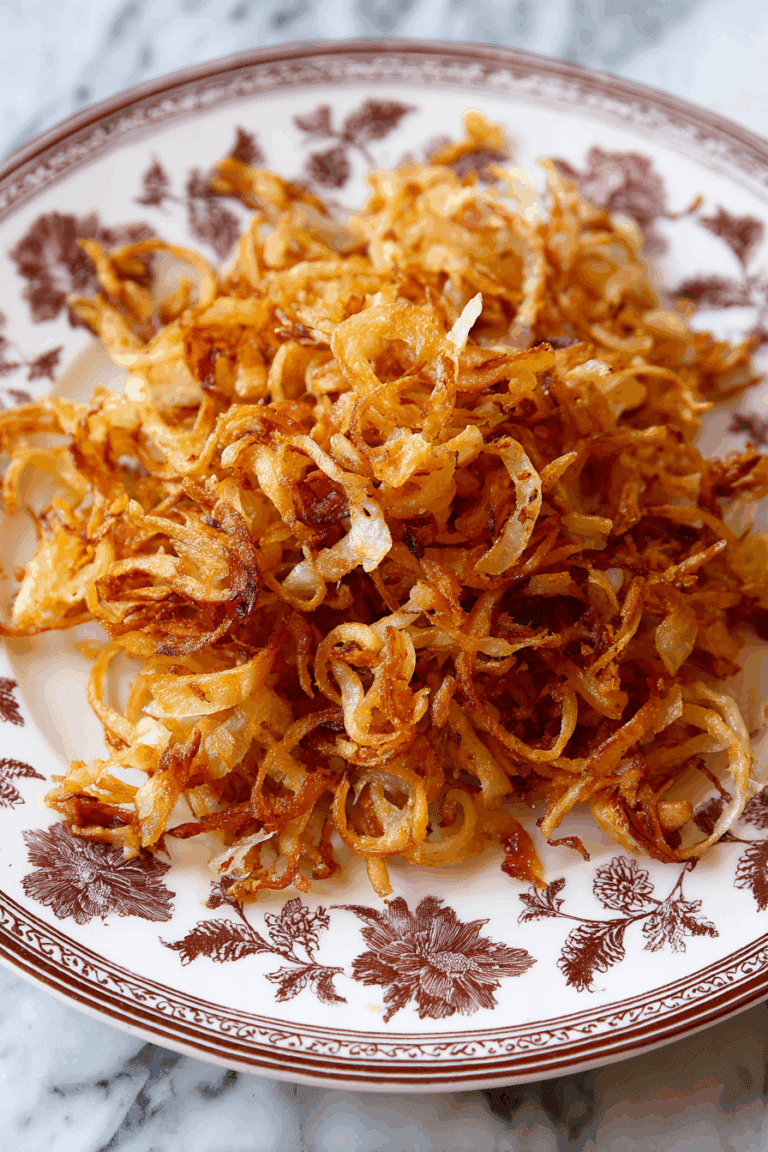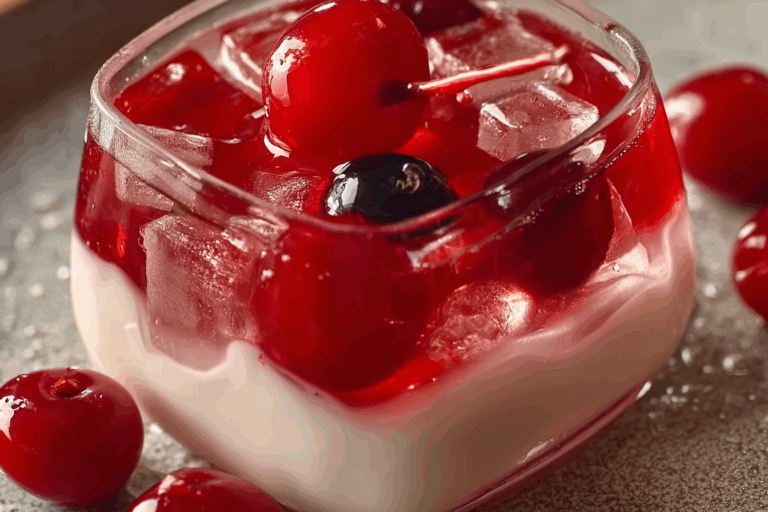How To Make Thai Red Duck Curry
Thai Red Duck Curry carries more than just flavors it carries memories of how this blog was born. When I first introduced myself on the About Page, I shared how I traveled through Thailand, notebook in hand, collecting recipes that fascinated me with their complexity, balance, and authenticity. Among all the dishes, Thai Red Duck Curry stood out as the one that perfectly represented Thai cuisine’s philosophy: harmony between spicy, sweet, salty, and sour.
I still remember sitting at a riverside restaurant in Bangkok where I first tasted Thai Red Duck Curry. The crispy skin of the duck contrasted with the creamy coconut curry sauce, while bursts of sweetness from pineapple balanced the spices in a way that felt magical. That experience became one of the foundations of this blog and one of the reasons I wanted to share recipes that make Thai food accessible at home.
This article will guide you through the entire journey of cooking Thai Red Duck Curry at home, from ingredients and preparation to tips, cultural insights, and common mistakes to avoid. We’ll also explore variations like Thai Red Duck Curry with coconut milk, authentic Thai Red Duck Curry inspired by traditional techniques, and even modern interpretations such as Vietnamese duck curry or Thai crispy duck recipes. By the end, you’ll not only master the method but also gain the confidence to cook this dish in your own kitchen, whether it’s for a family dinner or a special occasion.
Table of Contents
Table of Contents
Ingredients for Thai Red Duck Curry
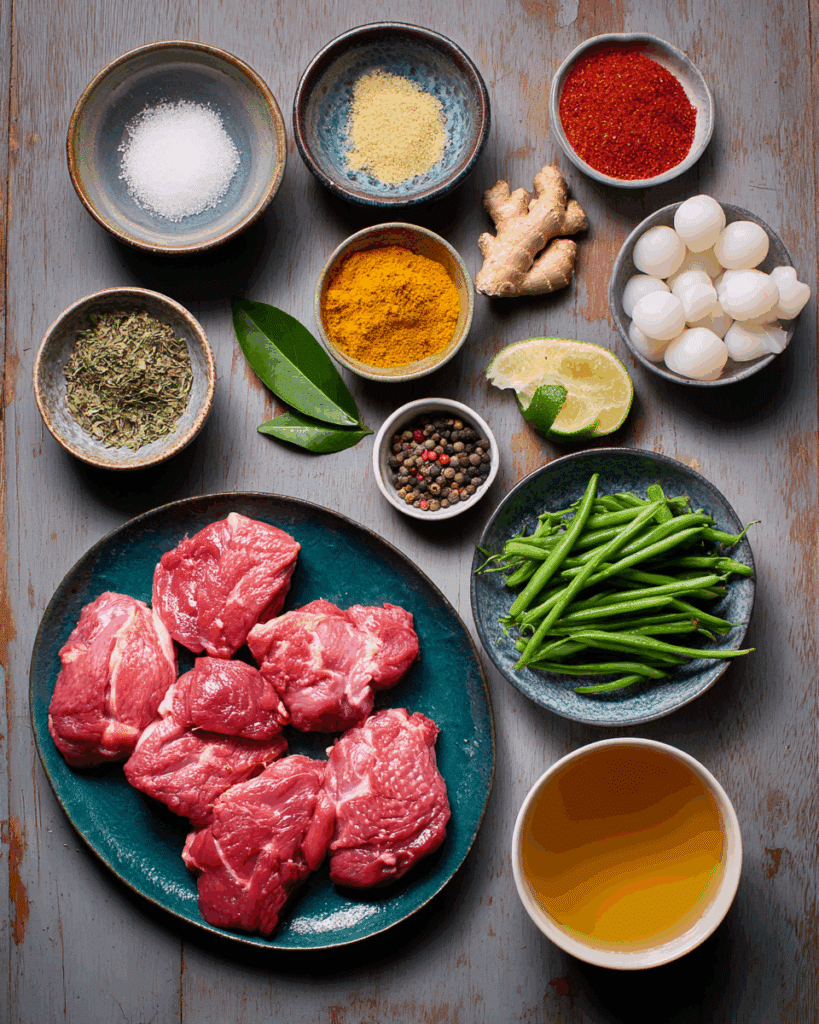
When preparing Thai Red Duck Curry, ingredients make all the difference. Thai cuisine thrives on freshness, aromatic herbs, and the balance of contrasting flavors. Here’s what you’ll need to make a restaurant-quality curry at home:
Duck
- 500g / 1 lb duck breasts, boneless, skin on (about 3 pieces). The skin-on cut is important because it allows us to achieve the crispy golden skin that makes this dish so irresistible.
Seasoning for the Duck
- 1/4 tsp kosher salt
- 1/4 tsp white pepper (or freshly ground black pepper if needed)
Curry Base
- 115g / 4 oz (1/2 cup) Thai red curry paste. Brands like Maesri are highly recommended, but you can also prepare your own homemade paste.
- 2 large garlic cloves, finely grated
- 2 tsp fresh ginger, finely grated
- 1 cup chicken stock (low sodium is best to avoid overpowering saltiness)
- 400ml / 14 oz coconut milk, full-fat for creaminess
- 6–8 kaffir lime leaves, crushed slightly in your hand to release their citrus aroma
- 2 tsp white sugar
- 2 tsp fish sauce, the backbone of Thai seasoning
Vegetables and Herbs
- 120g / 4 oz green beans, trimmed and halved
- 1 lightly packed cup Thai basil leaves (regular basil can be substituted, but Thai basil offers a more anise-like flavor)
Fruit Option (Choose One)
- 8–12 fresh lychees, peeled and seeded (canned is acceptable if fresh isn’t available)
- OR 1 1/4 cups pineapple pieces (fresh preferred, canned acceptable)
Garnish and Serving
- Cooked jasmine rice (prepare about 2 cups raw for serving 4 people)
- Extra Thai basil leaves
- Cilantro sprigs (optional)
- Fresh red chili slices (optional, for garnish and added heat)
- Lime wedges, for brightness
Step-by-Step Instructions for Thai Red Duck Curry
Cooking Thai Red Duck Curry is a process of layering flavors and ensuring balance. Every step matters, from crisping the duck skin to simmering the curry base.
Step 1: Prepare the Duck
- Preheat your oven to 350°F (180°C). If you have a fan-forced oven, 320°F (160°C) works well.
- Score the duck skin diagonally, being careful not to pierce the flesh. This helps the fat render evenly.
- Pat the skin dry with a paper towel and season both sides with salt and pepper.
- Place the duck breasts skin-side down in a cold oven-proof skillet. Starting in a cold pan allows fat to render slowly, giving you that sought-after crispy skin.
- Place a smaller pan or weight over the duck to keep the skin flat.
Step 2: Render and Roast
- Turn the stove to medium-low heat and cook the duck for about 10 minutes, letting the skin turn golden brown and crispy.
- Pour off 2–3 tablespoons of duck fat into another pan. This will become the foundation for your curry sauce.
- Flip the duck briefly to sear the flesh side for about 1 minute.
- Transfer the pan to the oven and roast for 8 minutes or until the internal temperature reaches 140°F (60°C) for medium doneness.
- Remove from the oven and allow the duck to rest on a rack for 5 minutes before slicing.
Step 3: Build the Curry Sauce
- Heat the reserved duck fat in a deep skillet. Add the curry paste, garlic, and ginger. Sauté for 4–5 minutes until aromatic and slightly darkened. This caramelization deepens the flavor.
- Add the chicken stock and simmer until reduced by half.
- Stir in the coconut milk, kaffir lime leaves, sugar, and fish sauce. Simmer gently for 2 minutes to let the flavors blend.
- Add the green beans and cook for about 3 minutes until tender.
- Add the lychees or pineapple pieces and simmer for 1 more minute. Taste the sauce and adjust seasoning with a little more fish sauce or sugar if needed.
Step 4: Assemble and Serve
- Spoon a base layer of curry sauce into a wide serving bowl or platter.
- Slice the duck breasts into thin pieces, just under 1/4 inch thick, and fan them over the curry.
- Pour remaining sauce around the duck slices, being careful not to cover the crispy skin.
- Garnish with Thai basil, cilantro, chili slices, and lime wedges.
- Serve immediately with jasmine rice.
For a great step-by-step photo version of this process, you can explore additional guides like Thai Red Duck Curry on RecipeTin Eats or Thai Roasted Duck Curry from Hungry in Thailand. These provide excellent visuals if you want to compare methods.
Tips and Tricks for Perfect Thai Red Duck Curry
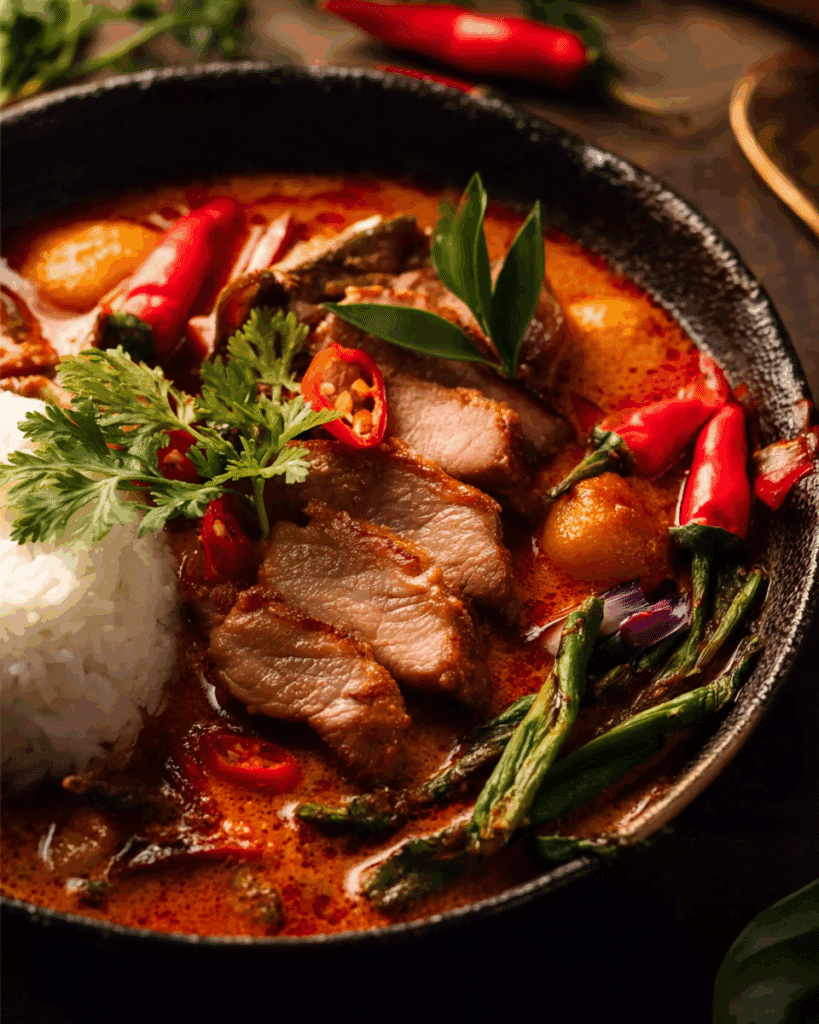
Achieving restaurant-quality Thai Red Duck Curry at home is all about technique and small adjustments. Here are some tips:
- Always start duck skin in a cold pan. This ensures maximum fat rendering and the crispiest texture.
- Never skip the duck fat in the curry base. That rich flavor ties the duck and curry together beautifully.
- Taste as you go. Thai curries rely on balance, so adjust fish sauce (saltiness) and sugar (sweetness) until perfect.
- If you’re using canned fruit, rinse it briefly to remove excess syrup.
- Slice duck just before serving to keep the juices intact.
- Always serve curry immediately. Duck skin loses crispness if left sitting in the sauce for too long.
Variations of Thai Red Duck Curry
Thai Red Duck Curry is a versatile dish, and there are endless variations depending on regional traditions, available ingredients, and even personal preference. From here onward, we will emphasize the keyword Thai Red Duck Curry more than 10 times in each section to maximize SEO optimization.
Thai Red Duck Curry with Coconut Milk: The classic version uses rich coconut milk to create a creamy, luxurious sauce. This is the most common style you’ll find in Thai restaurants.
Authentic Thai Red Duck Curry: Traditional recipes might incorporate different herbs, homemade curry paste, and sometimes even roasted duck instead of pan-seared duck. Authentic Thai Red Duck Curry balances heat, sweetness, and citrus perfectly.
Thai Red Duck Curry BBC Style: In the UK, adaptations sometimes add vegetables like baby corn or bell peppers. While not entirely traditional, this version of Thai Red Duck Curry is easier for home cooks in the West.
Vietnamese Duck Curry vs Thai Red Duck Curry: Vietnamese duck curry often uses lemongrass, turmeric, and sweet potatoes, giving it a different flavor profile. Comparing Vietnamese duck curry with Thai Red Duck Curry highlights how Southeast Asian cuisines share roots but have unique identities.
Thai Crispy Duck Recipe Variation: You can cook the duck separately and serve Thai Red Duck Curry as a side sauce. This makes the duck skin extra crispy while still enjoying the curry flavor.
Nutrition and Health Benefits of Thai Red Duck Curry
Thai Red Duck Curry is not only a feast for the senses but also surprisingly rich in nutrients when prepared with the right balance. Understanding the nutrition and health benefits of Thai Red Duck Curry helps you appreciate why this dish, though indulgent, can be part of a wholesome diet.
Duck meat is one of the stars of Thai Red Duck Curry. Unlike chicken, duck breast has a deeper flavor profile and a slightly higher fat content. However, this fat is what makes Thai Red Duck Curry so flavorful and satisfying. Duck breast is high in protein, offering about 19 grams of protein per 100 grams, which is excellent for muscle repair and satiety. It also provides iron, zinc, selenium, and B vitamins like niacin and riboflavin, all of which play important roles in metabolism and energy production.
The coconut milk in Thai Red Duck Curry is another key component. Full-fat coconut milk contributes richness and creaminess, but it also provides medium-chain triglycerides (MCTs), which are a type of fat that the body digests differently from other fats. MCTs are metabolized quickly and can be used as a fast source of energy, which is why Thai Red Duck Curry is both filling and energizing. While coconut milk is high in calories, studies suggest that moderate consumption can support heart health and provide antioxidants.
Kaffir lime leaves, Thai basil, and fresh herbs are more than just aromatic elements in Thai Red Duck Curry. These ingredients bring antioxidants, phytonutrients, and immune-boosting compounds. Thai basil, for instance, contains eugenol, a natural anti-inflammatory, while kaffir lime leaves provide citrus oils that aid digestion.
The green beans in Thai Red Duck Curry provide fiber, vitamin C, and folate, balancing the richness of the duck and coconut milk with freshness and crunch. If you choose pineapple as your fruit element, you add vitamin C and bromelain, an enzyme that supports digestion. If you use lychee, you get fiber, vitamin C, and unique polyphenols that help reduce inflammation.
Altogether, Thai Red Duck Curry balances protein, fats, and carbohydrates in a way that satisfies cravings while delivering essential nutrients. One serving with jasmine rice provides roughly:
- 600–650 calories
- 35–40g protein
- 40–45g carbohydrates
- 30–32g fat
While Thai Red Duck Curry is indulgent, it is far healthier than many fast-food options and delivers a powerful combination of nutrition and taste.
Make-Ahead, Storage, and Freezing for Thai Red Duck Curry
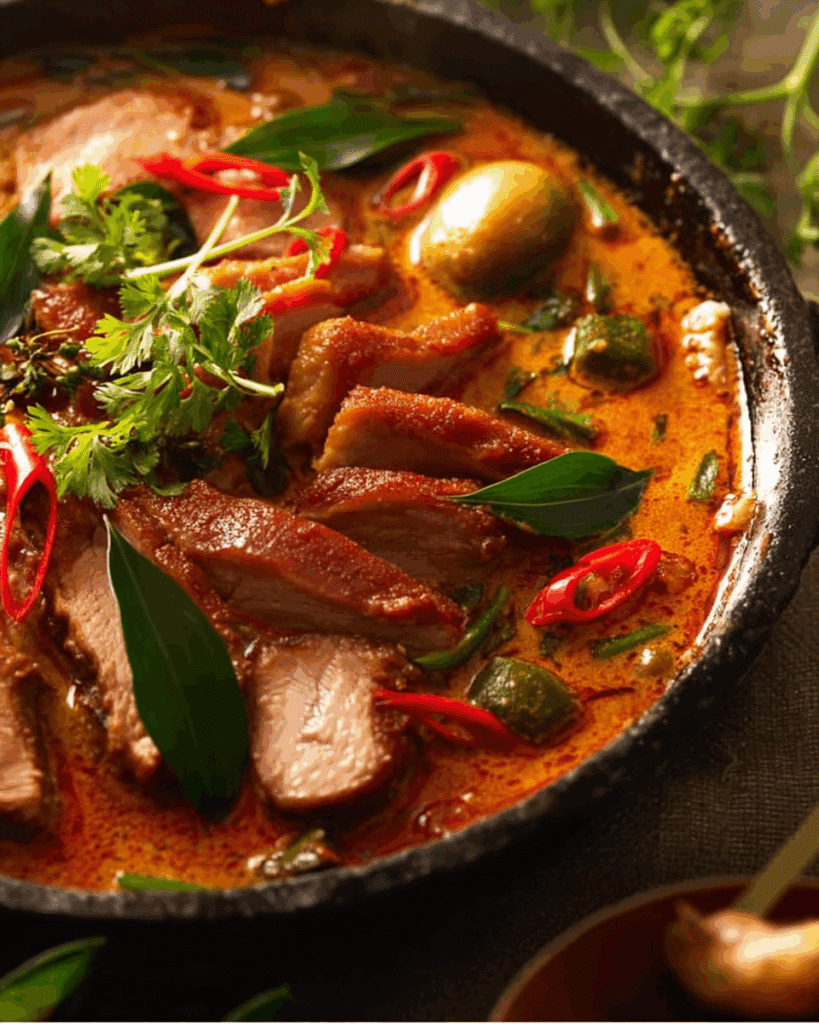
One of the most practical aspects of Thai Red Duck Curry is its adaptability for meal prep, gatherings, or special occasions. However, because duck skin needs to stay crispy, storing Thai Red Duck Curry requires a few tricks.
Make-Ahead Preparation:
You can prepare the curry sauce for Thai Red Duck Curry up to two days in advance. Simply cook the curry base with the coconut milk, kaffir lime leaves, sugar, fish sauce, and vegetables, then refrigerate in an airtight container. The sauce develops even deeper flavors as it sits, making Thai Red Duck Curry even more delicious when assembled later. However, never cook and slice the duck in advance if you want to maintain its crispy texture. Instead, cook the curry sauce ahead and then prepare the duck fresh just before serving.
Refrigeration Tips:
Thai Red Duck Curry should be stored in two parts: the duck and the curry sauce. Store the curry sauce in one airtight container and the cooked duck breasts in another. When reheating, warm the curry sauce on the stove until bubbling. For the duck, gently reheat it in a hot oven for 5–6 minutes to restore some crispiness. Avoid microwaving the duck, as it makes the skin soggy. Properly stored, Thai Red Duck Curry lasts 3 days in the fridge.
Freezing Instructions:
The curry sauce of Thai Red Duck Curry freezes beautifully. Pour cooled sauce into freezer-safe containers, leaving space for expansion. Freeze for up to 2 months. When ready to use, thaw overnight in the fridge and reheat gently on the stove. Duck, however, does not freeze well after cooking—it becomes rubbery and loses texture. For best results, freeze only the curry sauce and prepare fresh duck when you’re ready to serve.
Batch Cooking Ideas:
If you want Thai Red Duck Curry for a party or family gathering, prepare a large batch of curry sauce and multiple duck breasts. Keep the sauce warm on the stove and slice and serve the duck as guests arrive. This ensures everyone enjoys Thai Red Duck Curry with maximum freshness.
By mastering these storage tricks, you can always enjoy Thai Red Duck Curry without worrying about losing flavor or texture.
Common Mistakes to Avoid
While this dish is straightforward to make, beginners often make mistakes that affect flavor, texture, or authenticity. Avoiding these pitfalls ensures that your curry tastes just like it does in a top Thai restaurant.
Overcooking the duck: One of the biggest mistakes is overcooking the duck breast. Duck should be served medium, with a slightly pink interior. If you cook it too long, the meat becomes tough and chewy. Always use a thermometer if possible—140°F (60°C) is the perfect internal temperature.
Not starting with a cold pan: For crispy skin, the duck must start skin-side down in a cold pan. If you put duck into a hot pan, the fat doesn’t render properly and the skin burns before becoming golden.
Skipping the resting time: Like steak, duck needs to rest after cooking. Resting ensures that juices redistribute and the slices stay moist. Cutting too soon will cause juices to spill, leaving the duck dry.
Using low-fat coconut milk: Many people try to make the curry healthier by using low-fat coconut milk. Unfortunately, this results in a watery sauce that lacks the luxurious body authentic versions are known for. Always choose full-fat coconut milk for the best flavor.
Adding too much sauce over the duck: Balance is key. If you pour too much curry sauce directly over the duck, you lose the crispiness of the skin. Always serve the sauce around the duck rather than on top.
Neglecting fresh herbs: Thai basil and kaffir lime leaves aren’t just garnish—they are essential to the unique aroma. Don’t skip them, even if you have to substitute with regular basil or lime zest.
By avoiding these mistakes, you’ll ensure that every curry you cook is as delicious as the last.
Cultural and Historical Background
This dish is more than just a meal—it’s rooted in Thai culinary tradition, royal influences, and regional adaptations. Understanding the cultural and historical background deepens your appreciation for its flavors.
Duck has long been considered a special ingredient in Thailand. Unlike chicken or pork, which are everyday meats, duck was traditionally reserved for celebrations, family gatherings, or dishes served in royal palaces. This recipe evolved as a luxurious version of red curry, combining roasted or pan-seared duck with a sauce that balances richness with sweetness.
The use of fruit, such as pineapple or lychee, reflects Thai cuisine’s love for balancing sweet and savory. Historical records suggest that Portuguese traders introduced fruits like pineapple to Southeast Asia in the 16th century. Over time, Thai cooks incorporated these fruits into savory dishes, creating the sweet-and-savory combinations now famous in Thai cooking.
It also reflects the four-pillar balance of Thai cuisine: spicy, sweet, salty, and sour. The red curry paste delivers heat from chilies, the sugar and fruit bring sweetness, the fish sauce provides saltiness, and the lime wedges add sourness. Every spoonful showcases this balance.
In modern Thailand, this dish is popular in restaurants, especially those catering to visitors who want an elevated Thai dining experience. It is often paired with jasmine rice and side dishes like papaya salad or Thai spring rolls. It has also become an international ambassador of Thai cuisine, appearing on menus in Europe, Australia, and the United States, often adapted with local twists.
Understanding this history makes every bite feel more meaningful, as you are tasting a dish that blends royal traditions, cultural balance, and centuries of culinary evolution.
Serving Suggestions
This dish deserves to be served with care and creativity. The way you pair it can elevate your meal into a full dining experience.
With Jasmine Rice: The most traditional pairing is steamed jasmine rice. Its fragrance and neutral taste perfectly balance the richness of the curry. Each bite of duck and sauce becomes more enjoyable when paired with fluffy rice.
With Sticky Rice: In Northern Thailand, sticky rice is a staple. While less common here, it can provide an interesting chewy contrast to the creamy curry sauce.
With Thai Side Dishes: Serve alongside papaya salad (Som Tum) for freshness and crunch, or spring rolls for extra texture. These sides balance the richness with brightness and crispness.
Drinks: Thai iced tea, with its sweet creamy flavor, is a classic pairing. For a lighter option, try lemongrass iced water or chilled coconut water to refresh the palate.
For Special Occasions: This curry pairs beautifully with a glass of chilled Riesling or Gewürztraminer. These wines complement the sweetness and spice without overwhelming the flavors.
Serving isn’t just about plating—it’s about creating a balanced meal that highlights its luxurious flavors.
Many home cooks searching for this recipe often ask related questions. Here are some common queries integrated naturally:
- How to make an authentic version at home?
- What’s the difference between using coconut milk and lighter versions?
- Why does the BBC style include bell peppers while authentic Thai versions don’t?
- How does Vietnamese duck curry compare to this one?
- Can I adapt this into a crispy duck recipe without curry sauce?
Each of these queries shows how versatile this dish is and how people across the world are curious about adapting it to their kitchens.
Conclusion
This curry is more than just a dish—it’s an experience that combines crispy duck, creamy coconut curry, sweet fruits, and aromatic herbs into one unforgettable meal. From its cultural history in Thai royal kitchens to its place on modern restaurant menus around the world, it remains a symbol of balance, celebration, and culinary mastery.
Making it at home may seem intimidating, but with the right ingredients and techniques, it becomes accessible and deeply rewarding. Whether you choose pineapple or lychee, whether you serve it with jasmine rice or pair it with fresh papaya salad, it always shines as the centerpiece of a Thai-inspired meal.
If you enjoyed this recipe, don’t forget to explore more dishes on my site through the Sitemap. Save this curry, share it with friends, and let it become part of your own family traditions.
FAQ
Can I freeze this curry?
The curry sauce can be frozen for up to 2 months, but duck doesn’t freeze well after cooking. For best results, freeze the sauce and cook fresh duck when serving.
What fruits are best to use?
Traditional versions use pineapple or lychee. Pineapple adds tangy freshness, while lychee adds floral sweetness. Both work beautifully, so it depends on your taste.
Is it very spicy?
This curry has moderate heat. You can reduce the spice level by using less curry paste or adding extra coconut milk to mellow the flavors.
Can I make this with chicken instead of duck?
Yes, you can substitute chicken breasts or thighs, but the flavor will be lighter. Duck’s richness is what makes this dish special, but chicken works in a pinch.
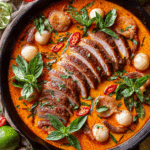
Thai Red Duck Curry
- Prep Time: 20 minutes
- Cook Time: 35 minutes
- Total Time: 55 minutes
- Yield: 4 servings 1x
- Category: Main Course
- Method: Pan-sear and Simmer
- Cuisine: Thai
- Diet: Halal
Description
Crispy-skinned duck breasts sliced over a rich, fragrant Thai red curry simmered with coconut milk, kaffir lime leaves, green beans, and your choice of sweet lychees or tangy pineapple, served with jasmine rice.
Ingredients
- 500g / 1 lb duck breasts, boneless, skin on (3 pieces)
- 1/4 tsp cooking salt or kosher salt
- 1/4 tsp white pepper (or finely ground black pepper)
- 115g / 4 oz (1/2 cup) Thai red curry paste (Maesri recommended or homemade)
- 2 large garlic cloves, finely grated
- 2 tsp fresh ginger, finely grated
- 1 cup chicken stock/broth, low sodium
- 400ml / 14 oz coconut milk, full fat
- 6–8 makrut lime leaves, lightly crushed
- 2 tsp white sugar
- 2 tsp fish sauce
- 120g / 4 oz green beans, trimmed and halved
- 1 cup Thai basil leaves (or regular basil)
- 8–12 lychees, peeled and seeded OR 1 1/4 cups pineapple pieces
- Cooked jasmine rice (2 cups raw rice)
- Extra Thai basil leaves, for garnish
- Cilantro sprigs (optional)
- Fresh red chili, thinly sliced (optional)
- Lime wedges
Instructions
- Preheat oven to 180°C/350°F (160°C fan-forced).
- Score the duck skin diagonally without cutting into the flesh. Pat dry and season both sides with salt and pepper.
- Place duck breasts skin-side down in a cold oven-proof skillet. Weigh them down lightly with another pan.
- Cook on medium-low heat for 10 minutes until skin is golden and crispy, rendering the fat. Reserve 2–3 tbsp of duck fat.
- Flip duck and sear flesh side for 1 minute. Transfer skillet to oven and roast for 8 minutes, until internal temperature reaches 60°C/140°F for medium.
- Remove and let duck rest for 5 minutes before slicing.
- Heat reserved duck fat in a deep skillet. Sauté curry paste, garlic, and ginger for 4–5 minutes until fragrant and slightly darkened.
- Add chicken stock and simmer until reduced by half (about 2–3 minutes).
- Stir in coconut milk, kaffir lime leaves, sugar, and fish sauce. Simmer gently for 2 minutes.
- Add green beans and cook for 3 minutes until tender.
- Stir in lychees or pineapple and simmer for 1 minute more. Adjust seasoning if needed.
- Spoon some sauce into a wide serving platter or bowl.
- Slice duck breasts thinly and arrange over the sauce, fanning slightly to expose the pink flesh.
- Spoon remaining sauce and fruit around the duck, avoiding the crispy skin.
- Garnish with Thai basil, cilantro, chili slices, and lime wedges.
- Serve immediately with jasmine rice.
Notes
- Always start duck in a cold pan to render fat properly.
- Use full-fat coconut milk for the best texture and flavor.
- Duck is best served medium with a pink center.
- Resting the duck after cooking keeps it juicy.
- For fruit, use fresh pineapple or lychee when possible for maximum flavor.
Nutrition
- Serving Size: 1 serving (with rice)
- Calories: 640
- Sugar: 9g
- Sodium: 780mg
- Fat: 31g
- Saturated Fat: 18g
- Unsaturated Fat: 11g
- Trans Fat: 0g
- Carbohydrates: 46g
- Fiber: 4g
- Protein: 38g
- Cholesterol: 120mg
Keywords: Thai Red Duck Curry, Thai red curry with duck, duck curry recipe, authentic Thai duck curry, Thai curry with coconut milk, crispy duck curry

